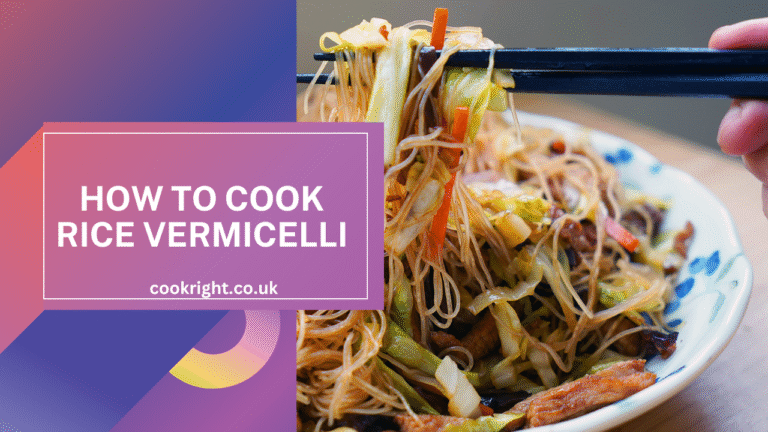Welcome to CookRight.co.uk, where culinary traditions from around the globe meet in your kitchen. As an international chef living in the UK, I have the unique privilege of bringing diverse flavors and cultural stories to your table. Today, I am thrilled to introduce you to a beloved staple of West African cuisine: Ogbono Soup.
Ogbono Soup, also known as Draw Soup, is a heartwarming dish that embodies the essence of West African cooking. Made from ground ogbono seeds, which lend the soup its distinctive thick and slimy texture, this dish is a celebration of bold flavors and rich heritage. Whether you’re seeking a new culinary adventure or looking to reconnect with your roots, Ogbono Soup is a recipe that promises to captivate your taste buds and nourish your soul.
Join me as we delve into the secrets of crafting the perfect Ogbono Soup, blending traditional ingredients with modern techniques to create a dish that is both authentic and accessible. Let’s embark on this delicious journey together, right here on CookRight.co.uk.
Ingredients
To make a delicious Ogbono Soup, you will need the following ingredients:
- 1 cup of ground ogbono seeds

- 2 cups of assorted meats (beef, tripe, or goat meat)
- 1 cup of smoked fish or stockfish
- 1/2 cup of crayfish (ground)
- 1/2 cup of palm oil
- 2-3 cups of water or meat stock
- 1 medium onion (chopped)
- 2-3 bouillon cubes (or to taste)
- 1 teaspoon of ground pepper (optional)
- 2 tablespoons of ground uziza seeds (optional)
- 2 cups of chopped spinach or bitter leaves
- Salt to taste
Explanation of Key Ingredients:
- Ogbono Seeds: The star ingredient of this dish, ogbono seeds are harvested from wild mangoes and ground into a fine powder. They are responsible for the soup’s unique thick and slimy texture, which is both hearty and comforting.
- Palm Oil: This bright red oil is extracted from the fruit of the oil palm tree. It adds a rich, earthy flavor and vibrant color to the soup.
- Crayfish: Ground crayfish gives the soup a distinct umami flavor and adds depth to the taste profile.
- Assorted Meats: Traditional Ogbono Soup is made with a variety of meats, which could include beef, tripe, or goat meat. These proteins add richness and make the soup more filling.
- Smoked Fish or Stockfish: These ingredients contribute a smoky flavor that enhances the overall taste of the soup.
Possible Substitutions:
- Ogbono Seeds: If you can’t find ogbono seeds, you can substitute with ground okra, which will provide a similar thickening effect, though the flavor will be slightly different.
- Palm Oil: For a healthier alternative, you can use olive oil, though it won’t have the same authentic flavor and color. Coconut oil is another substitute but will impart a different taste.
- Crayfish: If ground crayfish is not available, you can use dried shrimp powder or omit it if seafood allergies are a concern.
- Smoked Fish or Stockfish: Canned mackerel or fresh fish fillets can be used if smoked fish is unavailable. Alternatively, you can add more meat or use dried seafood for a similar taste.
- Uziza Seeds: These can be hard to find, so you can use a mix of black pepper and nutmeg as a substitute to achieve a similar spicy and aromatic flavor.
By using these ingredients and substitutions, you can recreate the authentic taste of Ogbono Soup in your own kitchen, no matter where you are.
Preparation Steps
Detailed Steps for Preparing the Ingredients:
- Prepare the Ogbono Seeds:
If you have whole ogbono seeds, grind them into a fine powder using a spice grinder or a mortar and pestle. Store the ground ogbono in an airtight container until ready to use. - Prepare the Meat:
– Wash the assorted meats (beef, tripe, or goat meat) thoroughly.
– Cut the meat into bite-sized pieces.
– Season the meat with salt and one bouillon cube.
– In a large pot, add the meat and enough water to cover it. Bring to a boil, then simmer until the meat is tender. This should take about 45 minutes to an hour. Save the meat stock for the soup. - Prepare the Fish:
– If using smoked fish, rinse it under cold water to remove any dirt or sand.
– Soak stockfish in hot water for a few minutes to soften it, then rinse and break into pieces.
– Remove any bones and set the fish aside. - Prepare the Crayfish:
– If you have whole crayfish, grind them into a powder using a spice grinder or mortar and pestle. This can also be done ahead of time and stored in an airtight container. - Prepare the Vegetables:
– Wash the spinach or bitter leaves thoroughly. If using spinach, chop it coarsely.
– If using bitter leaves, wash them repeatedly to reduce their bitterness. - Prepare the Onions and Peppers:
– Peel and chop the onion into small pieces.
– If using fresh peppers, wash and blend them into a smooth paste.
My Personal Tips for Efficient Prep Work:
- Organize Your Ingredients: Before starting, ensure all your ingredients are measured and ready. This is often referred to as “mise en place” and helps streamline the cooking process.
- Batch Tasks: Perform similar tasks together, such as chopping all vegetables before moving on to meat preparation. This minimizes cleaning time and keeps your workspace tidy.
- Use Pre-Ground Ingredients: To save time, you can buy pre-ground ogbono seeds and crayfish. Just ensure they are fresh and of high quality.
- Prep Ahead: You can prepare the meats and fish a day in advance. Simply store them in the refrigerator until you’re ready to cook.
- Soften the Stockfish Early: If using stockfish, start soaking it early in the preparation process as it can take time to soften.
- Save the Stock: The meat stock is an important part of the soup’s flavor. Strain it to remove any impurities and set it aside for when you start cooking the soup.
- Multi-task: While the meat is boiling, you can prepare the other ingredients to save time.
By following these preparation steps and tips, you’ll ensure a smooth and efficient cooking process, making it easier to create a delicious Ogbono Soup.
Cooking Instructions
- Heat the Palm Oil: In a large pot, heat the palm oil over medium heat until it becomes clear and slightly hot. Avoid overheating to prevent burning the oil.
- Toast the Ogbono: Add the ground ogbono seeds to the hot palm oil. Stir continuously for about 2-3 minutes. This helps to release the flavors of the ogbono seeds and prevents lumps from forming.
- Add the Meat Stock: Gradually add the meat stock (or water) to the pot while stirring to combine with the ogbono mixture. Continue to stir until the mixture thickens and becomes smooth. This should take about 5-7 minutes.
- Incorporate the Meats and Fish: Add the cooked assorted meats and any remaining stock to the pot. Stir to combine.
Add the smoked fish or stockfish pieces, ensuring they are well-distributed in the soup. - Season the Soup: Add the ground crayfish, chopped onions, and ground pepper (if using). Stir to mix well.
Crumble in the bouillon cubes and add salt to taste. Adjust seasoning as needed. - Simmer and Cook: Reduce the heat to low and let the soup simmer for about 15-20 minutes. Stir occasionally to prevent sticking and to ensure all the ingredients are well integrated.
- Add the Vegetables: Add the chopped spinach or washed bitter leaves to the pot. Stir to incorporate them into the soup. Let it simmer for another 5-10 minutes until the vegetables are tender and the flavors have melded together.
- Final Adjustments: Taste the soup and adjust the seasoning if necessary. If the soup is too thick, you can add a little more water or stock to reach your desired consistency.
Serving Suggestions
Ogbono Soup is a versatile and hearty dish that can be served with various traditional and modern accompaniments. Here are some suggestions on how to serve it:
- Fufu: This staple West African dish made from cassava, yams, or plantains complements the rich and slimy texture of Ogbono Soup perfectly.
- Pounded Yam: Similar to fufu but specifically made from yams, pounded yam offers a smooth and stretchy texture that pairs well with the thickness of the soup.
- Garri (Eba): Made from dried grated cassava, garri when mixed with hot water turns into a dough-like consistency, making it another ideal accompaniment for dipping into Ogbono Soup.
- Amala: A dough made from yam flour with a slightly sour taste, amala is a traditional favorite that balances the rich flavors of the soup.
- Rice: For a less traditional option, serve Ogbono Soup as a sauce over plain steamed rice. This can be a lighter alternative but still very satisfying.
Conclusion
Creating Ogbono Soup is not just about following a recipe; it’s about bringing a piece of West African culinary heritage into your kitchen. This hearty, flavorful soup is more than a meal; it’s a celebration of rich flavors, diverse textures, and cultural tradition. By using fresh, authentic ingredients and adhering to the detailed steps provided, you’ve hopefully crafted a dish that’s both satisfying and memorable.
I encourage you to dive into the process, experiment with the accompaniments, and maybe even put your own twist on this classic recipe. Cooking is a journey, and dishes like Ogbono Soup make that journey incredibly rewarding. Whether you’re cooking for yourself, your family, or friends, this soup is bound to stir conversations and create moments of shared joy.
Thank you for choosing to explore this recipe with CookRight.co.uk. I look forward to hearing about your experiences and any personal touches you added to make Ogbono Soup your own. Don’t forget to share your delicious creations and culinary adventures online, and keep coming back for more tasty insights and recipes. Happy cooking!




